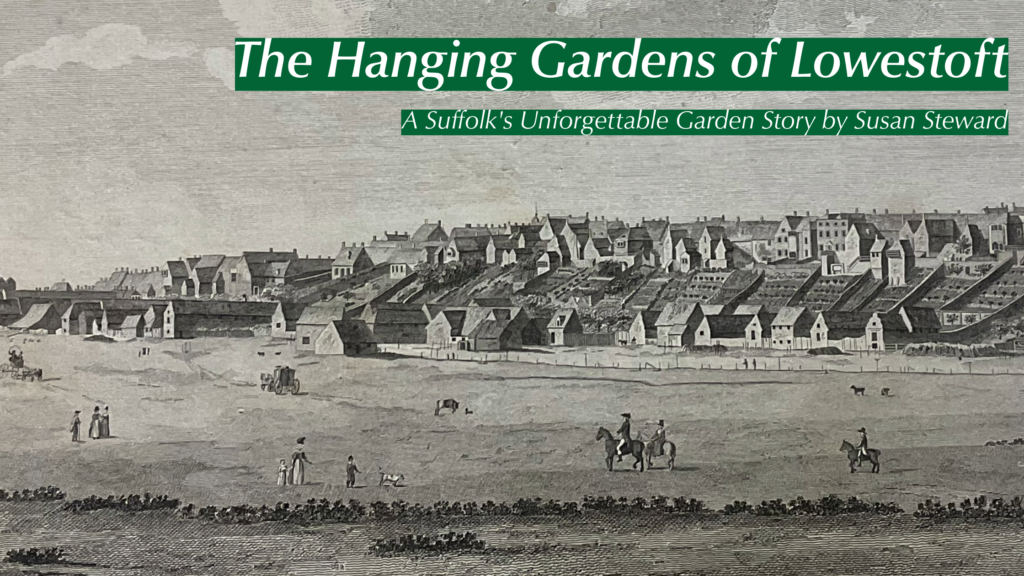Over the past year, volunteers on our Suffolk’s Unforgettable Garden Story project have been researching local parks, gardens and other designed landscapes to help protect them for future generations. Here we share the research of volunteers Susan Steward & Harry Grainger, who have been investigating a fascinating garden history story on her very doorstep…
The Hanging Gardens of North Lowestoft
by Susan Steward & Harry Grainger
New house, new garden
In 2018 we moved house – from an old house in the centre of Norwich to an even older house on the cliff in north Lowestoft. While only 30 miles down the road it moved us a great distance – not only from Norfolk to Suffolk but also from a provincial city to the most easterly town by the sea. The house, of course, came with a garden – it too had become overgrown and unkempt – but it was the garden that was to lead to our greatest surprise and to other projects that we could not have previously imagined.
Early settlement on, and development of, the cliff
In researching the history of our house we also became aware that we could not understand our new/old house without understanding the development of other houses neighbouring it and the land these were built on. Local historians believe that the cliff was developed for housing in the 1300s and was stabilised first through a system of terraces that stretched for nearly a mile down from its highest point to its lowest, a drop of some 50 feet (about 15 metres) from north to south. Although put in for building purposes, these terraces became an integral part of each dwelling with the first terrace being used for household storage, the third and fourth for fishing sheds and the like while the second terrace – the focus of interest for this study – were given over to gardening and cultivation. These second terraces became known as Lowestoft’s Hanging Gardens and our own garden, we found out, was one of these.
The gardens on the cliff were not only for the enjoyment of those who owned the houses above but were also visible to visitors to the town from the grassy area below and from the sea. The commanding vista of the cliff and its gardens was captured in an etching by J. Cole at around the same time (shown below), also indicating that the fame of the cliff was not only acknowledged locally but nationally too.

Change of use over time
Research in the Lowestoft Record Office indicated that our house had been rented out as a pub in the mid 1800s (rumoured to be even a brothel!) and that there were other houses on the cliff that were similarly rented out for purposes other than the fishing trade that in previous times the owners had engaged in, meaning that the gardens were of no importance to those trying to make a living there.
A trawl through the internet showed that many artists had come to Lowestoft and drawn aspects of it. We knew of one such drawing – an etching by Edwin Edwards entitled ‘Old Lowestoft’ from 1867 and we suspected that this might be our neighbour’s garden at that time. Further research about Edwin Edwards uncovered a large travelogue of his visit to Lowestoft as he travelled through the Eastern Counties from London to Great Yarmouth. We had been told that there was an etching in this book entitled ‘George and Dragon, Lowestoft’ and expected a view from the High Street, we were astonished when we saw that he had drawn our house from the bottom of the garden, not focusing on it being a pub at all.

Edwards deliberately drew the house from below because his focus was actually the ‘hanging garden’ that belonged to it:
“These gardens are the peculiar feature of Lowestoff – the old street with its old fashioned houses, its balconies, platforms, bay-windows and all sorts of quaint projections is built on the top of the height, below are the steeply shelving gardens hanging over […] the large flat and sandy and grassy shore where the fishermen dry their nets, where are their sheds, their lofts and store-rooms, rope yards and curing houses.”
The next stage of our story comes when an antique seller buys the house and the one next door in 1981. The two gardens were made one – the previous owner’s great passions were gardening and garden design and so the gardens were once again terraced (into the seven that still exist today) and were restored to glory once more.

What future for Lowestoft’s Hanging Gardens?
We are still busy working on our old house and its gardens – there is so much to do when a property is so old and has been neglected for a long time. We now have only one house and ‘hanging garden’ (large enough to keep us very busy) to restore and maintain. Our neighbours in other properties in the High Street tend to their gardens with differing interest and investment – some are private oases of calm and tranquillity to be enjoyed by the home occupier (owner or tenant) while others are neglected and overgrown.
We are lucky to have our own ‘hanging garden’ but many who live in the High Street, in our community, have no green space to call their own or to share. We have a vision for bringing back some part of the Hanging Gardens of North Lowestoft and to give our Scores a rationale once more. We want to celebrate our unique surroundings – the cliff, the sea – and put Lowestoft proudly on the Garden Map again through the creation of new Hanging Gardens for all in modern times.

To read the full research article by Susan Steward and Harry Grainger click the link below.




